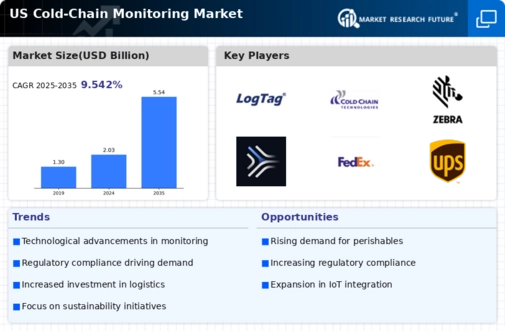Rising Demand for Perishable Goods
The increasing consumption of perishable goods in the US is a primary driver for the cold chain-monitoring market. As consumers become more health-conscious, the demand for fresh produce, dairy products, and meat has surged. According to recent data, the perishable food market is projected to grow at a CAGR of 5.5% through 2026. This growth necessitates robust cold chain solutions to ensure product quality and safety during transportation and storage. Consequently, businesses are investing in advanced monitoring technologies to maintain optimal temperature and humidity levels, thereby reducing spoilage and waste. is therefore positioned to benefit from this trend., as companies seek to enhance their supply chain efficiency and meet consumer expectations for freshness.
Consumer Awareness and Safety Concerns
Growing consumer awareness regarding food safety and quality is a significant driver for the cold chain-monitoring market. With rising incidents of foodborne illnesses, consumers are more vigilant about the conditions under which their food is stored and transported. This heightened awareness has led retailers and suppliers to prioritize cold chain integrity, ensuring that products are kept at safe temperatures throughout the supply chain. According to industry reports, 70% of consumers are willing to pay a premium for products that guarantee freshness and safety. As a result, businesses are compelled to invest in advanced cold chain-monitoring solutions to meet these consumer demands, thereby propelling market growth.
E-commerce Growth and Home Delivery Services
The rapid expansion of e-commerce and home delivery services in the US is driving the cold chain-monitoring market. As online grocery shopping becomes increasingly popular, the need for efficient cold chain logistics has intensified. E-commerce platforms require reliable monitoring systems to ensure that perishable items are delivered in optimal conditions. The online grocery market is projected to grow by 25% annually, further emphasizing the necessity for effective cold chain solutions. Companies are now focusing on integrating sophisticated monitoring technologies to track temperature and humidity levels during transit, ensuring product quality upon delivery. This trend is likely to bolster the cold chain-monitoring market as businesses adapt to the evolving retail landscape.
Regulatory Pressures and Compliance Requirements
Regulatory pressures surrounding food safety and quality are a crucial driver for the cold chain-monitoring market. The US government has implemented stringent regulations to ensure that perishable goods are stored and transported under appropriate conditions. Compliance with these regulations is essential for businesses to avoid penalties and maintain consumer trust. The cold chain-monitoring market is experiencing growth. Companies are investing in monitoring solutions that facilitate compliance with these regulations.. For instance, the FDA mandates that temperature-sensitive products must be monitored throughout the supply chain. As businesses strive to meet these compliance requirements, the demand for advanced cold chain-monitoring technologies is expected to rise, further propelling market growth.
Technological Advancements in Monitoring Solutions
Technological innovations are significantly influencing the cold chain-monitoring market. The advent of IoT devices, blockchain technology, and AI-driven analytics has transformed how temperature-sensitive products are tracked and managed. For instance, IoT-enabled sensors provide real-time data on temperature fluctuations, allowing for immediate corrective actions. The market for IoT in cold chain logistics is expected to reach $10 billion by 2027, indicating a strong shift towards smart monitoring solutions. These advancements not only improve operational efficiency but also enhance compliance with safety regulations. As businesses increasingly adopt these technologies, the cold chain-monitoring market is likely to experience substantial growth, driven by the need for enhanced visibility and control over the supply chain.
























Leave a Comment